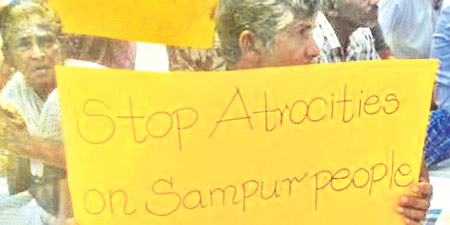Sampur: A clash of ideas
by Rukshana Rizwie
In the latest turn of events over the proposed 500 Megawatt coal
power plant in Sampur, India has agreed to begin consultations with Sri
Lanka on 'pursuing other eco-friendly options' in place of the proposed
coal power plant, according to Ceylon Electricity Board (CEB) sources.
 |
|
Residents protest against
the proposed Sampur Power Plant Project
(tamilguardian.com) |
It was widely reported that, when President Maithripala Sirisena met
Indian Prime Minister Narendra Modi recently, the controversial Sampur
Power plant had figured prominently during bilateral discussions.
Sri Lankan High Commissioner to India, Esala Weerakoon, was quoted as
saying Modi had responded positively to Sri Lanka's request.
"We have not terminated the international tenders called for the
Sampur Power Plant yet," Sulakshana Jayawardena, Spokesperson for the
Ceylon Electricity Board (CEB) told the Sunday Observer. "Both countries
have resumed discussions, but no decision has been arrived at," he said.
He said a decision had not been reached since a wide range of
possibilities are still being considered.
"The setting up of the Liquefied Natural Gas (LNG) is only an option,
as various other proposals have been forwarded and are to be
considered."
Impact on environment
Meanwhile, sources at the Power and Energy Ministry confirmed that
the coal power plant at Sampur has been shelved.
"The Cabinet Committee on Economic Management has discussed it at
length. It was decided, due to the social and environmental concerns,
all plans to set up a coal power plant in Sampur will be shelved," the
Ministry sources said .
According to them, there has been stiff opposition to the coal power
plant from the Leader of Opposition R. Sampanthan, who expressed
reservations about the project.
"I am concerned about the impact of the plant on people living nearby
and those returning to the area after the conflict," Sampanthan said. "I
have spoken to the Indian counterparts and have raised the matter with
officials here," he said.
Over the last few months, opposition for the Sampur Coal power plant
gained momentum when it was revealed that a conditional approval was
granted to the initial Environment Impact Assessment Report (EIA).
Environmentalists and residents in Sampur say the EIA cannot be
considered since it was done at a time when there were very few
settlements.
Concerns over its pollution aspect has also been raised, with many
pointing to the fact that at a time when many countries were turning
away from coal, Sri Lanka was beginning to initiate a project of this
nature.
Indian officials have warned that deviating from the original plan
might not be practical.
"Tenders have been called, the site in Sampur cordoned off, the EIA
report prepared, and a lot of work and money has been put in to the
project," the officials said.
"If it is shelved at this point, it could entail additional
costs,"they said.
Open discussions
An official at the Power and Energy Ministry, also supportive of the
plant, said the legality of switching over needed to be discussed in the
open.
The Sampur coal power plant is to be built in a 500 acre land in the
Trincomalee district of the Eastern Province with financial assistance
from India.
The thermal power plant to be built by India's State owned National
Thermal Power Corporation NTPC Ltd at an estimated cost of US$ 600
million will add 500 megawatts to the National Grid.
The Memorandum of Understanding for the Sampur power plant initially
meant to be a coal-powered power station was signed on 29 December 2006,
between the CEB and the NTPC.
The Power Purchase Agreement, BOI Agreement, Land Lease Agreement and
Coal Supply Agreement were signed in 2013 by the Sri Lankan Government,
CEB and the Trincomalee Power Company Limited. |

